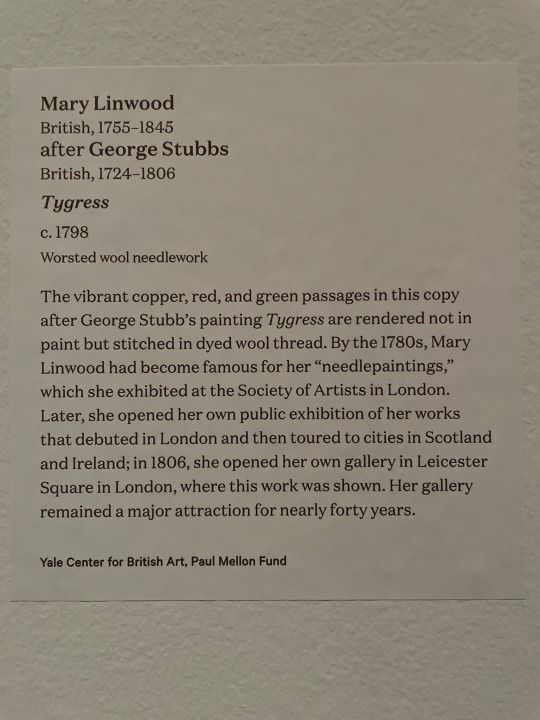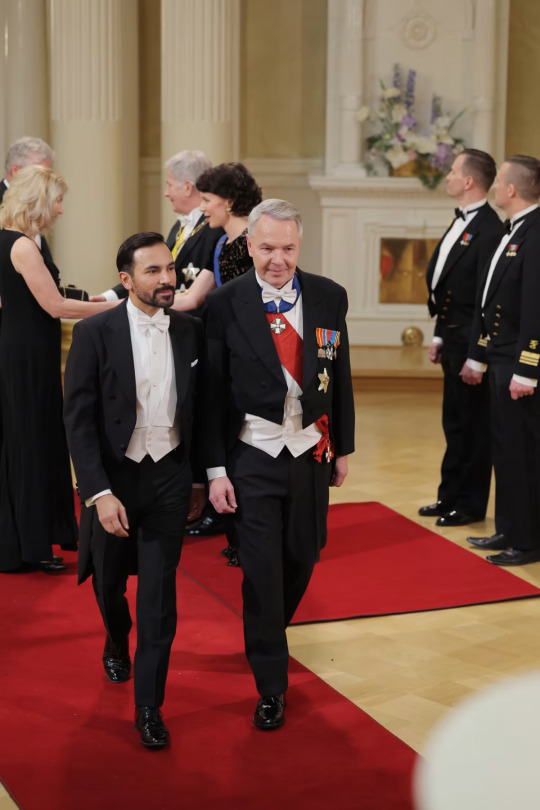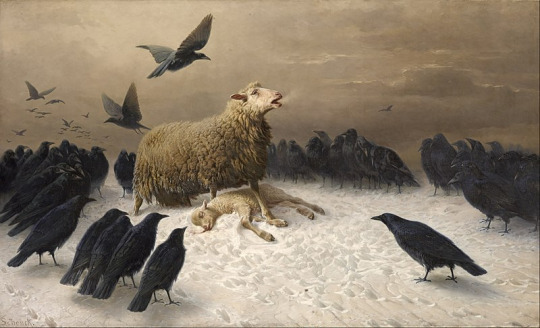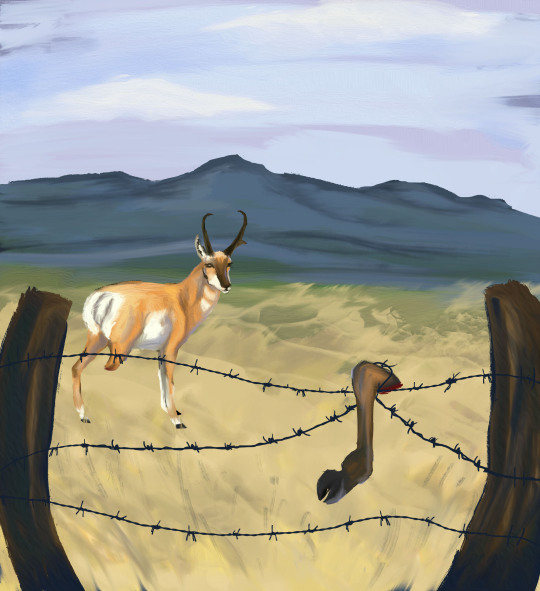#major stubbes
Text
#TextileTuesday: look closely, it’s a “needlepainting!” A favorite piece from the “Making Her Mark: A History of #WomenArtists in Europe, 1400-1800” exhibition at Baltimore Museum of Art:




Mary Linwood (British, 1755-1845)
after George Stubbs (British, 1724-1806)
Tygress, c. 1798
Worsted wool needlework
“The vibrant copper, red, and green passages in this copy after George Stubb's painting Tygress are rendered not in paint but stitched in dyed wool thread. By the 1780s, Mary Linwood had become famous for her ‘needlepaintings,’ which she exhibited at the Society of Artists in London.
Later, she opened her own public exhibition of her works that debuted in London and then toured to cities in Scotland and Ireland; in 1806, she opened her own gallery in Leicester Square in London, where this work was shown. Her gallery remained a major attraction for nearly forty years.”
#animals in art#european art#18th century art#needlework#needlepainting#textiles#Mary Linwood#museum visit#exhibition#British art#George Stubbs#tiger#feline#wild cat#Baltimore Museum of Art#women artists
237 notes
·
View notes
Text
HELSINKI (AP) — A 12-year-old student opened fire at a secondary school in southern Finland on Tuesday morning, killing one and seriously wounding two other students, police said. The suspect was later apprehended.
Heavily armed police cordoned off the Viertola school — a large educational institution including lower and upper secondary schools with a total of about 800 students — in the city of Vantaa, just outside the capital, Helsinki, after receiving a call about a shooting incident at 09:08 a.m.
Police said both the suspect and the victims were 12 years old.
One of the students had died instantly after being shot, Chief of Police Ilkka Koskimäki from the Eastern Uusimaa Police Department told a news conference. The other two were seriously wounded, he said.
The weapon used in the shooting was a registered handgun that was licensed to the suspect’s relative, Detective Inspector Kimmo Hyvärinen said.
The suspect was detained in the Helsinki area less than one hour after the shooting with a handgun in his possession, police said. He admitted to the shooting in an initial police hearing but there is no immediate word of the motive, police said, adding that the case is being investigated as a murder and two attempted murders.
Finnish President Alexander Stubb and Prime Minister Petteri Orpo offered condolences to the families of the victims in postings on X with both saying they were shocked over the shooting.
“What makes it particularly shocking is the age of the victim and the suspect,” Orpo said during a news conference later Tuesday. “I can assure you that this (shooting) will be carefully reviewed and conclusions will be drawn that this will not happen again.”
The minimum age of criminal liability in Finland is 15 years, which means the suspect cannot be formally arrested. A suspect younger than 15 can only be heard by the police after which they will be handed over to Finland’s child welfare authorities.
In the past decades, Finland has witnessed two major deadly school shootings.
In November 2007, a 18-year-old student armed with a semi-automatic pistol opened fire at the premises of the Jokela high school in Tuusula, southern Finland, killing nine people. He was found dead with self-inflicted wounds.
Less than a year later, in September 2008, a 22-year-old student shot and killed 10 people with a semi-automatic pistol at a vocational college in Kauhajoki, southwestern Finland, before fatally shooting himself.
In the Nordic nation of 5.6 million, there are more than 1.5 million licensed firearms and about 430,000 license holders, according to the Finnish Interior Ministry. Hunting and gun-ownership have long traditions in the sparsely-populated northern European country.
Responsibility for granting permits for ordinary firearms rests with local police departments.
Following the school shootings in 2007 and 2008, Finland tightened its gun laws by raising the minimum age for firearms ownership and giving police greater powers to make background checks on individuals applying for a gun license.
The Interior Ministry said Finland will pay respects to the victims of the school shooting on Wednesday when all state agencies and institutions will lower the national flag to half staff. Private households are encouraged to join in the commemoration, the ministry said.
36 notes
·
View notes
Text



Manchester Evening News - Saturday 26 November 1988
James Wilby loves to play life dangerously. Never an actor to take the easy option, he didn’t work for five months after the award winning title role in Maurice.
It wasn't the film’s homosexual love scenes that kept him on the dole however. James's own lust for the right project to advance his career made him reject all the offers that poured in. “It just takes one bad film and it can put you back miles,’’ he says.
Now following the major success in the starring role of the classic story of A Handful of Dust, blond, handsome James Wilby is taking chances again.
Not content with dominating all the dashing British screen roles in the Jeremy Irons mould, he's starring in A Summer Story, a distinctly unfashionable love story in an age when violent cop thrillers and special effects films top the box office.
“The challenge -- and it is quite a challenge-- is to get the mood absolutely right,’’ he says of the turn-of-the-century West Country story.
“What’s interesting about a love story is not two people falling in love it’s two people falling in love, in a particular way. And it's getting that right.”
No time was it harder than in nude scenes played between James and his pretty co-star Imogen Stubbs in a freezing West Country river and a hay loft at dead of night with temperatures plummeting.
“You have to be relaxed because the camera picks everything, every tensing muscle. It’s not easy to be totally relaxed and gaze lovingly into somebody’s eyes with technicians standing around watching!
Born in Rangoon and after an itinerate early life in Burma Ceylon and Jamaica James eventually took up acting as a hobby while studying maths at Durham University.
His hobby turned into an obsession and he ended up being accepted by RADA, which in turn led him straight into the West End cast of Another Country, the story of spy Guy Burgess, which also launched the careers of Rupert Graves (Dance With A Stranger) and Colin Firth (Tumbledown), and a vital Equity’ card.
Following that run the die was cast and Wilby started getting calls for roles that demanded his fresh-faced public schoolboy look.
“Am I worried about being typecast in classical roles? Yes, but all my parts so far have been very different, it’s only journalists who want to lump them all together.”
After a day spent as an extra on the worldwide Merchant/Ivory hit A Room With View-- “I was furious, my agent was promised it was a speaking part,” -- he was offered the lead in E M Forster’s autobiographical Maurice.
“I’ve no regrets at all about doing Maurice,” says James, who despite not having a holiday in four years managed to take one day off from work marry his long-time girlfriend.
“I don’t think I’ll play such a fascinating role for years. You get one those that fits you like glove every years or once in a lifetime.”
#James Wilby#James Wilby Interviews#A Summer Story#James Wilby doing love scenes#Imogen Stubbs#Frank Ashton#Megan David#Archived Interviews#1988
38 notes
·
View notes
Text
Results & analysis of the Finnish presidential election
By the narrowest margin since the direct popular vote was introduced in 1994, Alexander Stubb (National Coalition Party i.e. the main conservative party) won the presidential race against Pekka Haavisto (Green Party; technically ran as an independent) last night.

The margin was 3.2 percentage points - or less than 99,000 votes.
The first poll conducted after the first round predicted that Stubb would win 59 to 41, while the last poll released before the election was 54 to 46. Haavisto had the momentum and got the majority of votes cast on election day, but it wasn't enough to close the gap from early voting (which Stubb won 52.7 to 47.3).
Stubb's victory was largely decided by voters from urban settlements/townships, as well as rural areas. Towns/smaller cities were quite evenly divided between the candidates, whereas the bigger cities mostly went to Haavisto. Out of the ten largest cities, Stubb only managed to win four.
Map of constituencies & number of voters in each:

Support for Haavisto was particularly strong in Helsinki (where he got 57.7% of the vote), other cities with academic universities, the Swedish-speaking autonomous island region of Åland, and western Lapland (the northernmost part).
Stubb was strongest on the west coast (especially Swedish-speaking Österbotten). He also did well in the other cities in the Helsinki metropolitan area (e.g. Espoo and Vantaa, but also Kauniainen, the city with the highest gross income in Finland). And of course the townships and rural areas already mentioned above.
So what do we know about the reasons people voted the way they did? Well, we can look at a survey conducted last week, asking people who had already chosen their candidate why they wouldn't vote for the other guy:
Top 5 reasons not to vote for Stubb
His values: 51% of respondents
Doesn't bring the nation together: 39%
His views on foreign policy: 36%
Doesn't seem like a good leader: 32%
His political party: 31%
Top 5 reasons not to vote for Haavisto
His values: 45%
His partner [husband]: 41%
His views on foreign policy: 39%
Past political scandals: 36%
His political party: 35%
It's worth noting that both candidates have been known for their liberal values throughout their careers. Stubb represents liberal conservatism, which combines individual liberties with economic "liberties" i.e. minimal government intervention (low taxes and low regulation). Haavisto is a liberal moderate/centrist who represents the fiscal conservative wing of the Green Party; this means he's only slightly left of the centre.
In other words, their values really aren't that far apart, at least in the social/ethical sense! So, the answer likely has more to do with identity politics and the values that the candidates were seen as representing.
The elephant in the room is, of course, Haavisto's homosexuality. Sadly, that is still a dealbreaker for many people in Finland.
In a survey conducted during the first round, about 30% of all respondents said his husband was a reason not to vote for him, and the same was said by a disturbingly large 41% of Stubb voters in the second round. It also came up multiple times in interviews asking voters whose choice in the first round had been knocked out what they made of the candidates in the second round. People said they couldn't imagine two men welcoming guests to the President's Reception on Independence Day (a big televised event) or making state visits to countries where homosexuality wasn't as widely accepted (oh, the irony).

Haavisto & his husband at the reception in December 2023.
As for Stubb, he's always been an outspoken LGBTQ+ ally before. Which was why it was extremely disappointing when his campaign refused requests for comment on that first-round survey, citing his tight schedule. It felt like a pretty calculated move to avoid alienating these conservative voters. To his credit, though, he did condemn the result of the second survey very clearly in a televised debate.
Haavisto's sexuality wasn't the only thing that irked conservative voters, however. There was also the fact that he did civil service instead of military service.
There's been a lot of concern in Finland for a potential Russian attack in the future if they win their war of aggression against Ukraine. That's why we joined NATO last year. In general, both candidates had very similar views on security policy and our role in NATO, although Stubb was more hawkish about it and even said we could change the law to allow the transport of nuclear weapons as a deterrent (dealbreaker for many on the left, boon for many on the right).
By Finnish law, the president becomes commander in chief if war breaks out, and a lot of voters (especially along the Russian border) saw military service as a prerequisite for that job. Which is ridiculous. The whole idea is that the operations would be planned and the troops commanded by professional high-ranking officers, but a democratically elected civil leader should make the final decisions and unite the nation behind them. Haavisto has been awarded several military medals for his merits as a UN peace broker, for example, and even Stubb pointed out in a debate that it would be pretty rich of him as a Lance Corporal to start barking out orders in a military capacity.
And then there was of course their party background and the many ways that factored in. Stubb's Coalition Party is the current prime ministerial party with a very strong and active base (current support is 22.4%), while the Greens are a medium-sized party (8.2%). This was also reflected in campaign funding - the CP forked out five times as much money for Stubb's campaign as the Greens did for Haavisto. Stubb also had more big money donors, while Haavisto mostly relied on grassroots donations.
Both parties are pretty well established and also quite polarising to the "other side." The CP's policy of spending cuts + tax cuts is popular across the right and gets more and more unpopular the further left you go. The Greens' focus on climate change is extremely unpopular on the far right and in the rural areas, but extremely popular on the left and in the big cities. There's also a (largely racist) misconception on the right that the left wants open borders and condones terrorism. Haavisto's "past political scandal" was related to an operation to repatriate children of ISIS fighters a few years back - whereas Stubb had been gone from Finnish politics for a while, so his political skeletons (e.g. arrogantly lying to parliament as minister of finance) were buried deeper.
Now, differences in internal policy would have actually separated the candidates, but they weren't discussed as much during the election, because the president's official role is limited to foreign and security policy. Haavisto's experience in those was much more extensive and substantial, but Stubb's wasn't that bad either. They also agreed on most topics, which made for some boring debates.
Interestingly enough, when there was more focus on internal policy and people's everyday concerns towards the end of the campaign period, support for Haavisto increased. He found it important to show that he knew and cared about such matters, because the president is also a "leader in values." Stubb mostly tried to dodge and stonewall such questions because he found them irrelevant to the president's official duties, and when pressed for an answer, he came across as very privileged and glaringly oblivious.
But as mentioned, it was the other things that mattered more to the voters. The rural areas, smaller townships and west coast are conservative strongholds, and I guess they thought even a liberal conservative was better than a liberal moderate. Especially if the latter was also a gay environmentalist who didn't spend those all-important six to twelve months in the barracks.
So that was how we got President Stubb. A president who is presumed straight and has done his military service. A president with some foreign policy experience and a sort of hawkish NATO stance. A president who is liberal and will hopefully display those values more now that he doesn't need to worry about upsetting the bigots - but who is pretty far removed from the common people and whose ability to unite the nation and be a good leader is doubted by many on the left.
To end this on a nice and hopeful note, the candidates did their best last night promote that national unity. Apparently, they had agreed after their final TV debate that whoever won would come from the TV studio (where they would receive the result) to the other guy's event and address his supporters before going back to his own.

And sure enough: Stubb gave a short but seemingly heartfelt speech thanking Haavisto and his campaign for how respectful and constructive all their discussions and debates were, praised him as "one of the finest people he'd ever met", hinted at potential future cooperation in the field of peacemaking, jokingly apologised to Haavisto's husband for "stealing" him for the last few months, and encouraged everyone in Team Alex and Team Pekka to come together as Team Finland. Haavisto heartily congratulated him and wished him well.
So, I don't know. I remember how arrogant Stubb has always come across, and I remember his political history. I hate him for both those reasons, I hate his party, and I hate that the bigots got what they wanted. But I really liked his gesture last night, I like that he has liberal values, and I guess I may also grow to like his lack of interest in internal politics (the current president is also from the CP, and he has occasionally overstepped by voicing support for his party's austerity politics).
So, congrats and good luck to Alex Stubb, I guess. You're not my president, but I appreciate that you're trying to be.
11 notes
·
View notes
Text
The headlines sounded dire: “China Will Use AI to Disrupt Elections in the US, South Korea and India, Microsoft Warns.” Another claimed, “China Is Using AI to Sow Disinformation and Stoke Discord Across Asia and the US.”
They were based on a report published earlier this month by Microsoft’s Threat Analysis Center which outlined how a Chinese disinformation campaign was now utilizing artificial technology to inflame divisions and disrupt elections in the US and around the world. The campaign, which has already targeted Taiwan’s elections, uses AI-generated audio and memes designed to grab user attention and boost engagement.
But what these headlines and Microsoft itself failed to adequately convey is that the Chinese-government-linked disinformation campaign, known as Spamouflage Dragon or Dragonbridge, has so far been virtually ineffective.
“I would describe China's disinformation campaigns as Russia 2014. As in, they're 10 years behind,” says Clint Watts, the general manager of Microsoft’s Threat Analysis Center. “They're trying lots of different things but their sophistication is still very weak.”
Over the past 24 months, the campaign has switched from pushing predominately pro-China content to more aggressively targeting US politics. While these efforts have been large-scale and across dozens of platforms, they have largely failed to have any real world impact. Still, experts warn that it can take just a single post being amplified by an influential account to change all of that.
“Spamouflage is like throwing spaghetti at the wall, and they are throwing a lot of spaghetti,” says Jack Stubbs, chief information officer at Graphika, a social media analysis company that was among the first to identify the Spamouflage campaign. “The volume and scale of this thing is huge. They're putting out multiple videos and cartoons every day, amplified across different platforms at a global scale. The vast majority of it, for the time being, appears to be something that doesn't stick, but that doesn't mean it won't stick in the future.”
Since at least 2017, Spamouflage has been ceaselessly spewing out content designed to disrupt major global events, including topics as diverse as the Hong Kong pro-democracy protests, the US presidential elections, and Israel and Gaza. Part of a wider multibillion-dollar influence campaign by the Chinese government, the campaign has used millions of accounts on dozens of internet platforms ranging from X and YouTube to more fringe platforms like Gab, where the campaign has been trying to push pro-China content. It’s also been among the first to adopt cutting-edge techniques such as AI-generated profile pictures.
Even with all of these investments, experts say the campaign has largely failed due to a number of factors including issues of cultural context, China’s online partition from the outside world via the Great Firewall, a lack of joined-up thinking between state media and the disinformation campaign, and the use of tactics designed for China’s own heavily controlled online environment.
“That's been the story of Spamouflage since 2017: They're massive, they're everywhere, and nobody looks at them except for researchers,” says Elise Thomas, a senior open source analyst at the Institute for Strategic Dialogue who has tracked the Spamouflage campaign for years.
“Most tweets receive either no engagement and very low numbers of views, or are only engaged with by other accounts which appear to be a part of the Spamouflage network,” Thomas wrote in a report for the Institute of Strategic Dialogue about the failed campaign in February.
Over the past five years, the researchers who have been tracking the campaign have watched as it attempted to change tactics, using video, automated voiceovers, and most recently the adoption of AI to create profile images and content designed to inflame existing divisions.
The adoption of AI technologies is also not necessarily an indicator that the campaign is becoming more sophisticated—just more efficient.
“The primary affordance of these Gen AI products is about efficiency and scaling,” says Stubbs. “It allows more of the same thing with fewer resources. It's cheaper and quicker, but we don't see it as a mark of sophistication. These products are actually incredibly easy to access. Anyone can do so with $5 on a credit card.”
The campaign has also taken place on virtually every social media platform, including Facebook, Reddit, TikTok, and YouTube. Over the years, major platforms have purged their systems of hundreds of thousands of accounts linked to the campaign, including last year when Meta took down what it called “the largest known cross-platform covert influence operation in the world.”
The US government has also sought to curb the effort. A year ago, the Department of Justice charged 34 officers of the Chinese Ministry of Public Security’s “912 Special Project Working Group” for their involvement in an influence campaign. While the DOJ did not explicitly link the arrests to Spamouflage, a source with knowledge of the event told WIRED that the campaign was “100 percent” Chinese state-sponsored. The source spoke on the condition of anonymity as they were not authorized to speak publicly about the information.
“A commercial actor would not be doing this,” says Thomas, who also believes the campaign is run by the Chinese government. “They are more innovative. They would have changed tactics, whereas it's not unusual for a government communications campaign to persist for a really long time despite being useless.”
For the past seven years, however, the content pushed by the Spamouflage campaign has lacked nuance and audience-specific content that successful nation-state disinformation campaigns from countries like Russia, Iran, and Turkey have included.
“They get the cultural context confused, which is why you'll see them make mistakes,” says Watts. “They're in the audience talking about things that don't make sense and the audience knows that, so they don't engage with the content. They leave Chinese characters sometimes in their posts.”
Part of this is the result of Chinese citizens being virtually blocked off from the outside world as a result of the Great Firewall, which allows the Chinese government to strictly control what its citizens see and share on the internet. This, experts say, makes it incredibly difficult for those running an influence operation to really grasp how to successfully manipulate audiences outside of China.
“They're having to adapt strategies that they might have used in closed and tightly controlled platforms like WeChat and Weibo, to operating on the open internet,” says Thomas. “So you can flood WeChat and Weibo with content if you want to if you are the Chinese government, whereas you can't really flood the open internet. It's kind of like trying to flood the sea.”
Stubbs agrees. “Their domestic information environment is not one that is real or authentic,” he says. “They are now being tasked with achieving influence and affecting operational strategic impact in a free and authentic information environment, which is just fundamentally a different place.”
Russian influence campaigns have also tended to coordinate across multiple layers of government spokespeople, state-run media, influencers, and bot accounts on social media. They all push the same message at the same time—something the Spamouflage operators don’t do. This was seen recently when the Russian disinformation apparatus was activated to sow division in the US around the Texas border crisis, boosting the extremist-led border convoy and calls for “civil war” on state media, influencer Telegram channels, and social media bots all at the same time.
“I think the biggest problem is [the Chinese campaign] doesn’t synchronize their efforts,” Watts said. “They’re just very linear on whatever their task is, whether it’s overt media or some sort of covert media. They’re doing it and they’re doing it at scale, but it’s not synchronized around their objectives because it’s a very top down effort.”
Some of the content produced by the campaign appeared to have a high number of likes and replies, but closer inspection revealed that those engagements came from other accounts in the Spamouflage network. “It was a network that was very insular, it was only engaging with itself,” says Thomas.
Watts does not believe China’s disinformation campaigns will have a material impact on the US election, but added that the situation “can change nearly instantaneously. If the right account stumbles onto [a post by a Chinese bot account] and gives it a voice, suddenly their volume will grow.”
This, Thomas says, has already happened.
A post, written on X by an account Thomas had been tracking that has since been suspended, referenced “MAGA 2024” in their bio. It shared a video from Russian state-run channel RT that alleged President Joe Biden and the CIA had sent a neo-Nazi to fight in Ukraine—a claim that has been debunked by investigative group Bellingcat. Like most Spamouflage posts, the video received little attention initially, but when it was shared by the account of school shooting conspiracist Alex Jones, who has more than 2.2 million followers on the platform, it quickly racked up hundreds of thousands of views.
“What is different about these MAGAflage accounts is that real people are looking at them, including Alex Jones. It’s the most bizarre tweet I’ve ever seen,” Thomas said.
Thomas says the account that was shared by Jones is different from typical Spamouflage accounts, because it was not spewing out automated content, but seeking to organically engage with other users in a way that made them appear to be a real person—reminiscent of what Russian accounts did in the lead-up to the 2016 election.
So far, Thomas says she has found just four of these accounts, which she has dubbed “MAGAflage,” but worries there may be a lot more operating under the radar that will be incredibly difficult to find without access to X’s backend.
“My concern is that they will start doing this, or potentially are already doing this, at a really significant scale,” Thomas said. “And if that is happening, then I think it will be very difficult to detect, particularly for external researchers. If they start doing it with new accounts that don't have those interesting connections to the Spamouflage network and if you then hypothetically lay on top of that, if they start using large language models to generate text with AI, I think we're in a lot of trouble.”
Stubbs says that Graphika has been tracking Spamouflage accounts that have been attempting to impersonate US voters since before the 2022 midterms, and hasn’t yet witnessed real success. And while he believes reporting on these efforts is important, he’s concerned that these high-profile campaigns could obscure the smaller ones.
"We are going to see increasing amounts of public discussion and reporting on campaigns like Spamouflage and Doppelganger from Russia, precisely because we already know about them,” says Stubbs. “Both those campaigns are examples of activity that is incredibly high scale, but also very easy to detect. [But] I am more concerned and more worried about the things we don't know."
7 notes
·
View notes
Text
Action in Animal Art
Can anyone suggest any animal art that does a really good job with action/interactions/storytelling? Anything but "study of," even if the style is cool.
No real reason, except that I noticed that like the majority of bisons in art are just 🦬
I guess there are a number of pieces that feature action in the form of fighting/predation like apparently George Stubb's favorite interaction, horse v. lion:

But other than predation and mating-season fighting...
Oh, there's Albrecht Schenk's Anguish:

I also haven't done much other than "study of," but here are my two favorite drawings I've done that I think tell a little story:


71 notes
·
View notes
Text
*+:。.。 。.。:+*
"Baby it's cold outside.."
A/N: Listened to this song and got the motivation to make something about it with none other than our dearest Idia~ Thanks to @azlrse for helping me decide who to pick! I also included a text convo for idia's confession 🤭
TW: There are hints of freezing in the cold and cold weather. Also, ooc idia?? If I missed a warning please tell me immediately!!
Pairing(s): Idia Shroud x gender-neutral!reader
Fandom: Twisted Wonderland
Please refer to my masterlist to see the rest of my works!

Winter falling over NRC was something you never expected.
It's as if you were in the Arctic, it was freezing. But the cold didn't seem stop anyone, including you.
Running around the snow-covered court yard with Grim while having snow ball fights with Ace and Deuce, baking winter-themed pastries with Trey, causing chaos with Ruggie, hanging at the Mostro Lounge with Jade and Floyd, having Christmas make-overs with Vil, and hanging around with Lilia and Malleus in their dorm.
It was wonderful. But you felt you were lacking something,, or rather someone..
But of course, that specific someone happened to be Idia, your significant other. The shut-in scoffed at those who played in the snow, muttering phrases like "Who would go out at this time..." Or "Playing in the snow? Seriously?" He didn't mean to be rude majority of the time, but his sarcastic attitude couldn't help it.
His little brother, Ortho had tried multiple times to bring his brother out to have fun. But the 'fire-head' always refused. Being the angel he was, Ortho respected his brother, and didn't force him.
However, part of him felt sad that his brother never really went out and had fun like the others, thus resulting in Ortho using his tablet to always be on a call with Idia and bring it everywhere. The perfect solution!
Idia sighed. He appreciated his brother's efforts, but he wondered what was so special about going out and having fun in this type of weather. The only thing that would make him go out was a new video game, and of course, Y/N.
Let's dive into Idia's interest in Y/N, shall we?
He never knew how or why he became awfully interested in the prefect. Whether it be because they were usually his player 2 (besides Ortho), or because they just understand each other, he loved them. Eventually it came to the point where he caught feelings and confessed through a text, being too shy to see them in person.
.・。.・゜✭・.・✫・゜・。.

hun he really sent a meme for you, i'm jealous 😔
.・。.・゜✭・.・✫・゜・。.
And eventually, the relationship blossomed. It took a few complications here and there, but hey, it worked. And that's how you guys are until today.
He loved you, even with your insecurities or imperfections, weird habits, etc. Despite looking ignorant and such, he'd do anything if it meant it was for you.
"Idiaaa!!" Ortho exclaims, snapping him out of his thoughts. "Uh yeah?" He asks. "Are you alright? You seem to be zoning out, are you stressed? Or sick?!" His younger brother asks in worry, his eyes widening. "No, I'm fine. I'm just tired.." Idia replies, "I'll log off now Ortho, see you later." Ortho nods in relief, Idia standing up from his chair as he hangs up the call.
He looks down at the floor, rubbing his hands together in silence until he hears a knock at his door. He walks up to it slowly and opens it, thinking it was something that could annoy him. But his eyes widen as he sees his player 2 standing in front of him.
"U-uh hey Y/N.." He mutters from surprise. "Hey. I missed you, Idia. I haven't seen you all day." You reply, hugging the housewarden. He lets out a squeak in surprise but eventually melts into the hug, holding your form nervously. "Why don't you come outside?.." You ask, looking at his beautiful vibrant eyes. "Everyone's having fun, and you're missing out, babe." You remark.
"Going out at this time is clearly the worst." Idia replies. "I just wanna stay here and play my game.." You stare at the boy, wondering if you could change his stubborn mind.
Walking over to his chair, he sits down and looks at you. "You wanna play or something? Why are you staring at me like that..."
"I'm going out, gonna play in the snow with the rest!!" You exclaim with a grin. Idia's eyes widen, "B-But it says that the temperature is freezing! You'll freeze out there--"
"Then come with me..You'll keep me warm and we'll both have fun in the snow!" You reply. "I'm definitely not doing that, hard pass Y/N." He says, crossing his arms.
He hated rejecting you, but he wanted to stay inside.
"Idia, babe.. Please? For me?" You ask, mustering up all your courage to ask him. He sighs, "Baby it's cold outside.. I don't wanna freeze to death." You look down, upset.
Idia's eyes look over at your face, his heart throbbing when he sees your sad yet adorable expression.
He huffs before wrapping his arms around you, "But for you, I suppose I could.." You look up at him with wide eyes, smiling warmly before pecking his lips as his light complexion turns into a crimson red. Huh, if you think about it, it looks as red as Riddle's hair.
"Well then let's get dressed, player one!" You exclaim with a cheeky grin. Idia's blank frown forming into a slight smile.
Despite Idia not seeming to have a decent wardrobe, he did. And fortunately he had great clothing for the season, claiming that revealing clothing was too 'extrovert-looking' and he preferred clothes with long sleeves.
You, being overly excited dragged Idia along on the walk to the court-yard. He didn't hate it,, he was just surprised. So don't be clueless once you see his widened eyes after the walk.
Stepping out into the court-yard with your lover, you sigh in content as you look up, snowflakes falling from the sky.
"It's so pretty..." You muttered. Idia looked at you with a soft glance, "Just like you..." He whispered. "What was that babe?" You ask, his expression turning into shock as he stutters, "N-nothing!"
"Hey Y/N!!" Ace shouts from the other side of the court-yard, running to you a long with Deuce and Grim. Idia looks at the three, his eyes widening before hiding behind you.
"Geez where were you?! You owe me one can of tuna for scaring me!" Grim says, crossing his arms. "Where were you if you don't mind me asking, Y/N?" Deuce asks. "Sorry guys, didn't mean to scare you." You chuckle. Ace peers over your shoulder, getting a glance of Idia's hair and anxious face.
"H-hey is that.. The housewarden of Ignihyde?" He asks. "Oh, yeah. Idia's not used to talking to people so he's a bit anxious." You explain. They nod, "Seems like he's just shy to me." Grim replies. "T-that's different..!" Idia exclaims.
"Well, we gotta go Y/N. Riddle probably wants us to do some other task.." Ace sighs as Deuce nods in agreement. "We'll see you later, Y/N."
As they walk away, Grim looks at you grinning. "I'll go back to the dorm, time for me to get some rest!" The so-called mage prances off, leaving you and Idia alone.
"Idia it's okay, everyone's gone." You whisper, smiling. "Staying inside would've been better.." He mutters softly. "Awe c'mon, stop being such a kill-joy." You chuckle.
"Idia!!" Ortho exclaims, "You're here with Y/N too." He says while grinning.
"Ortho,, c'mere you little cutie!" You say while laughing, as Ortho runs through the layers of snow, "Catch me if you can onee-san!!"
Idia looks at the sight in front of him, sighing quietly before smiling. "Hey Player 1, come play with us." You tease, poking his cheek.
He nods softly before taking your hand in his. "Anything for you, Player 2."
Maybe it going out wasn't so bad afterall.
*+:。.。 。.。:+*
I apologize for the story going in different directions and looking random,, I couldn't do this well with my motivation (っ◞‸◟c)
Please tell me if there's any errors and such, likes and reblogs are deeply appreciated dearies
(*´ ˘ `*)♡

#twisted wonderland#twst wonderland#twst#twstファンアート#twst x reader#twisted wonderland x reader#twisted wonderland x mc#idia shroud#idia shroud x reader#idia x mc#idia x y/n#my first work for idia#i love u idia<3#but he's yours bestie :^^
257 notes
·
View notes
Text
FourTops - Baby I Need Your Loving (1964)
Their first taste of major commercial success at Motown, (they'd already been going 11 years by this point) and one of many top notch classics produced by Holland-Dozier-Holland. Levi Stubbs was one of the best male singers of all time.
26 notes
·
View notes
Text
The result of 2024 Finnish presidential election 🇫🇮 :

Because no candidate received a majority of votes, Alexander Stubb and Pekka Haavisto will contest a runoff on 11 February. The new presidential term will begin on 1 March 2024.
#suomi#finland#politics#politicians#politiikka#2024#january#tammikuu#suomipaskaa#suomiperkele#europe#presidentinvaalit#pekka haavisto#alexander stubb#jussi halla-aho#olli rehn#jutta urpilainen#li andersson#mika aaltola#sari essayah#harry harkimo#election
3 notes
·
View notes
Text
Alexander Stubb will be sworn in as Finland's president on Friday, as Sauli Niinistö wraps up 12 years in office.
Quick and articulate, Stubb's public speaking style contrasts significantly with that of Niinistö, who was often vague in his remarks, according to Hufvudstadsbladet.
The Swedish-language daily notes that when Stubb takes office, Finland gets a president who speaks five to six languages — Finnish and Swedish natively, fluent English and French, decent German as well as some Italian. That makes him one of the most linguistically skilled presidents in Finnish history.
The more language skills a president has, the less they have to rely on others, according to historian Henrik Meinander.
"[Former president] Urho Kekkonen could hardly speak any English and was therefore dependent on his aides," Meinander told HBL about the man who spent a quarter-century in office.
Housing shortage looms
Finland is now seeing fewer apartments built than at any time since the 1940s, Helsingin Sanomat reports.
The paper suggests that a massive housing shortage is imminent in a year or two, as demand will inevitably outstrip supply.
In the short term, the flats not selling now will help satisfy demand — but not for long, according to the paper, which notes that people keep flowing into urban areas. Additionally, Finland saw 72,000 people move to the country last year.
In 2023 construction began on some 16,000 apartments, and the same number can be expected this year. This figure is, however, half of normal levels. In comparison, 2021 saw construction start on 47,000 new apartments.
Finns and Finglish
Finnish coffee brand Paulig's summer job ad — mixing Finnish and English words — is raising eyebrows.
English-language words and phrases intermingled with Finnish in the advert included "customer service specialist", "strive for excellence", "stay curious", "grow together", "for a life full of flavor".
This week MPs debated issues related to the use and status of Finnish, and what some members see as threats to the majority national language. Some lawmakers called for the Finnish language to be protected in particular from the dominance of English.
Iltalehti talked to Sari Hyytiäinen of the Institute for the Languages of Finland (Kotus) to hear her view on the coffee company's Finglish job notice.
"If this situation is allowed to continue like this, it will only keep spreading," she told IL, although adding that Finnish has always borrowed words from other languages.
Responding to the criticism, Paulig said it was an international company operating in 13 countries.
"Our business language is English, and our shared values and commitments are company-wide, so they're only in English. This way, we also avoid the risk of losing something in translation," Paulig's comms department told IL.
2 notes
·
View notes
Text
David Ogden Stiers, Major Winchester on ‘M*A*S*H,’ Dies at 75

David Ogden Stiers, left, with Harry Morgan and William Christopher in a scene from “M*A*S*H.
By Anita Gates (04 March 2018)
David Ogden Stiers, the tall, balding, baritone-voiced actor who brought articulate, somewhat snobbish comic dignity to six seasons of the acclaimed television series “M*A*S*H,” died on Saturday at his home in Newport, Ore., a small coastal city southwest of Salem. He was 75.
His death was announced on Twitter by his agent, Mitchell K. Stubbs, who said the cause was bladder cancer.
Mr. Stiers joined the cast of “M*A*S*H” in 1977, when Larry Linville, who had played the pompous and inept Maj. Frank Burns, left the show. The series, a comedy-drama set in a Mobile Army Surgical Hospital during the Korean War, required a foil for its raucous, irreverent, martini-guzzling leads, Hawkeye Pierce (Alan Alda) and B.J. Hunnicutt (Mike Farrell), and Mr. Stiers’s imperious Maj. Charles Emerson Winchester III seemed to fit the bill.
Winchester’s upper-class Boston priggishness, however, turned out to be balanced by impressive medical skills, a heartfelt appreciation of the arts, real wit and a surprising level of compassionate humanity. Winchester was, unlike Frank Burns, a worthy adversary.
From the beginning, Mr. Stiers said, he felt confident about playing Winchester. “It’s just a matter of isolating the traits” from others in his own personality, he told The Salt Lake Tribune in 1977. But he confessed to one definite difference between himself and his aristocratic character. “Where he wears a smoking jacket to bed,” he suggested, “I often wear nothing but socks.”
The role earned Mr. Stiers two Emmy nominations (in 1981 and 1982). He was nominated a third time, in 1984, for his lead role in “The First Olympics: Athens in 1896,” a dramatic mini-series.
In a statement after his death, Loretta Swit, who played Maj. Margaret (Hot Lips) Houlihan on “M*A*S*H,” called Mr. Stiers “my sweet, dear shy friend,” adding, “Working with him was an adventure.”

Mr. Stiers, right, with Mike Farrell and Alan Alda on the set of “M*A*S*H” in 1980.
David Allen Ogden Stiers was born on Oct. 31, 1942, in Peoria, Ill., the son of Kenneth Stiers and the former Margaret Elizabeth Ogden. The family later moved to Eugene, Ore., where David graduated from high school.
After briefly attending the University of Oregon, he headed to California to pursue an acting career and worked with the Santa Clara Shakespeare Festival in California for seven years. In the late 1960s, he moved to New York to study drama at Juilliard.
There he became a member of John Houseman’s City Center Acting Company, making his Broadway debut with the company in 1973. He appeared in “The Three Sisters,” “The Beggar’s Opera” and three other plays, which ran in repertory.
He continued to appear on the New York stage in the 1970s and returned to Broadway later in his career, playing a beloved wartime general in the 2009-10 holiday run of “Irving Berlin’s White Christmas.”

Mr. Stiers as Reverend Brock in the musical “Tenderloin” at City Center in 2000.
Mr. Stiers had made his film debut with a small role in Jack Nicholson’s counterculture classic “Drive, He Said” (1971). That year, his voice was heard as the announcer in George Lucas’s debut feature film, the dystopian sci-fi drama “THX 1138.”
Voice roles went on to become an important part of Mr. Stiers’s career. He was in the cast of about two dozen Disney animated films, including “Lilo & Stitch” (2002), as the villain Jumba Jookiba, and “Beauty and the Beast” (1991), in which he was the voice of Cogsworth, a strong-willed pendulum clock. That character, often described as “tightly wound” and “ticked off,” suggests to the Beast at one point that he woo his love with “flowers, chocolates, promises you don’t intend to keep.”
Other movie work included roles in “Oh, God!” (1977), “The Man With One Red Shoe” (1985), “The Accidental Tourist” (1988) and four Woody Allen films. (He was a peculiar hypnotist in Mr. Allen’s “The Curse of the Jade Scorpion.”) His last screen appearance was in “The Joneses Unplugged,” a 2017 television movie about technology overload.
Like his “M*A*S*H” character, Mr. Stiers was a devoted fan of classical music. He conducted frequently and was the resident conductor of the Newport Symphony Orchestra (formerly the Yaquina Chamber Orchestra) in Oregon.
He never married. Some reports have suggested that he is survived by a son from an early relationship.
In early 2009, at 66, Mr. Stiers announced that he was gay and “very proud to be so” in a blog interview that was reported by ABC News. His secrecy, he said, had been strictly about the fear that openness about his sexuality might affect his livelihood. Now he regretted that.
“I wish to spend my life’s twilight being just who I am,” he said.
#i've not been able to read it since 2018 and i kinda needed to cry over it again#and sorry to kick off october on a sad note but i wanted this preserved somewhere that wasn't behind a fucking nyt paywall#shoutout to 15ft who always has my back <3#also thanks to finding this again i found a copy of 'tenderloin' cast recording on ebay so maybe i'll upload that later#i mean i'd like to unpack literally everything in this but tbh i just want to present this without comment and just let it be#david ogden stiers#mash#blue's post
32 notes
·
View notes
Text
Westworld Season 5 Not Happening As HBO Cancels Show
Westworld season 5 is officially not happening as HBO announces they are canceling the critically acclaimed sci-fi drama series.
HBO has decided to cancel Westworld following the conclusion of season 4 in August. Developed by Person of Interest alum Jonathan Nolan and his partner Lisa Joy, the series is an expanded adaptation of Michael Crichton's film of the same name revolving around the titular amusement park in which the androids populating the area begin to turn on the human guests. Evan Rachel Wood has led the cast of all four seasons of Westworld alongside Thandiwe Newton, Ed Harris, Jeffrey Wright, Tessa Thompson, Luke Hemsworth, Aaron Paul, Angela Sarafyan and Anthony Hopkins.
Following the generally divisive response to season 3 of the show, Westworld season 4 picked up seven years after the events of its predecessor in which humanity has lost the war against hosts and the faux Charlotte Hale taking control of the world and deploying a bioengineered virus that allows humans to come under control of hosts' orders. The season also saw a major time jump in which humanity is struggling to bounce back with the help of Maeve, who survived her previous confrontation with Charlotte, Stubbs and Bernard, who has potentially found the best course to save both humanity and hosts. Though not hitting the same critical heights of its first two seasons, Westworld season 4 scored more favorable reviews than its predecessor and ended with an ambiguous cliffhanger going into a planned season 5, though audiences eager to see the final chapter are getting some devastating news.
The Hollywood Reporter has brought word that HBO has officially canceled Westworld, shocking leaving the show without a season 5. Nolan and Joy had previously expressed their hopes to wrap the show up with one more season, even having reportedly been in talks to return, though the network has elected to have season 4 serve as its last. Check out the statement that HBO released below:
Over the past four seasons, Lisa and Jonah have taken viewers on a mind-bending odyssey, raising the bar at every step. We are tremendously grateful to them, along with their immensely talented cast, producers and crew, and all of our partners at Kilter Films, Bad Robot and Warner Bros. Television. It’s been a thrill to join them on this journey.
3 notes
·
View notes
Text
IVALO, FINLAND—Only 20 miles of forest separate the Lapland Border Guard base in the Finnish town of Ivalo from Russia. From here, well above the Arctic Circle, the Border Guards monitor the activities of their not-so-friendly neighbor. And now, after Finland joined NATO in April last year and Helsinki and Washington decided to further strengthen their cooperation by signing a defense cooperation agreement in mid-December, the United States is officially authorized to position troops and equipment at the base.
The United States has similar agreements facilitating military collaboration with the other NATO members bordering mainland Russia: Norway, Estonia, and Latvia. These agreements also specify which of the hosting country’s bases can be used by U.S. forces. After Finland and the United States signed the agreement, Ivalo became the closest base to mainland Russia immediately accessible to U.S. troops.
“It is premature to assess what will possibly be invested in Ivalo, and the criteria are not public,” says Ville Ahtiainen, the deputy commander of the Lapland Border Guard, “but the overall result will be good, and it will deepen the cooperation between our countries.”

NATO’s new 830-mile-long border in Finland draws the alliance’s attention much more to the north, says Kristine Berzina, the managing director of the Geostrategy North program at the German Marshall Fund think tank. The area, she says, has “not received much consideration in the past, especially from a land forces domain.”
This despite Russia’s powerful forces nearby, which include its crown jewels: the Northern Fleet and its nuclear submarines, held in and around the Russian port of Murmansk. The strategic harbor is so close that road signs point to it in Ivalo’s icy streets.
While Finland is counterbalancing Moscow’s superiority in the high north, the enhanced military presence comes with a trade-off. As Berzina notes, the new border also “increases exposure to Russian threats.” After the signing of the December agreement, Moscow declared that it “would take the necessary measures to counter the aggressive decisions of Finland and its NATO allies,” and it has many tools at its disposal. Whether it is weaponized migration, covert operations against infrastructure, or airspace violations, these hybrid attacks are now not only Finland’s problems, but also NATO’s.
In joining NATO, Finland abandoned the policy of military neutrality it had maintained since shortly after World War II. Despite being a NATO partner since 1994, the Nordic country had never been able to count on the protection of allies. Consequently, for decades it took care of its own defense, developing impressive military capabilities and a society trained to fight. According to military experts and security officials, Finland’s presence in NATO brings to the club a sort of Arctic Sparta, a highly trained force that will move the alliance’s center of gravity to the north. (The missing brick in the anti-Russian northern wall is Sweden, which is expected to join the alliance soon, once Hungary gives the green light.)
“Our biggest asset is the concept of total defense that we have developed in all these years,” says Ville Sipilainen, a special advisor to the Finnish defense minister, who closely followed the cooperation agreement’s negotiations. “As a small country, we had to use the entire society for defense. We have very developed infantry, artillery, and of course, the expertise in Arctic warfare.”
On Feb. 11, Finland will go to the polls to elect its new president. The two candidates, Alexander Stubb and Pekka Haavisto, share a decisive anti-Russian position, and no major changes in foreign policy are expected after the vote.
In Ivalo, dozens of young conscripts (usually between 19 and 21) have just arrived and shaved their heads to start military service. They can be seen marching around the base and learning the basic concepts of discipline in the first days. Finland is one of the few EU countries where military service is mandatory, and with 285,000 soldiers ready to be armed, it has one of the largest wartime infantries in NATO. (Around 900,000 people out of a total population of 5.5 million have had military training.)
The Border Guard in Ivalo trains the conscripts especially in reconnaissance along the frontier, where the atmosphere has recently been tense. Last fall, about 1,300 asylum-seekers from countries such as Somalia, Syria, Yemen, Kenya, Morocco, and Pakistan started showing up at Finland’s border crossing points, including the one close to Ivalo. Helsinki has accused Moscow of transporting the migrants to the border and pushing them to seek refuge on the other side, posing “a serious threat to Finland’s national security and public order.” At the end of November, the government closed the entire border, which will remain shut at least until April 14. Also last year, Helsinki started building a 124-mile fence along its eastern frontier.
Weaponized migration is not the only hybrid attack Moscow has been accused of recently. In October, a pipeline connecting Finland and Estonia was severely damaged by what Finnish investigators think was the anchor of a Chinese cargo ship. Rumors of Russian involvement have inflamed the debate in the media since. In the last weeks, GPS disturbances have also affected Finland and the Baltic region, and many Finns suspect that Russia is the source.
During the migrant crisis, the Border Guard received the support of one of, if not the, most skilled Arctic formations in the world: the Finnish Jaeger Brigade. Located in Sodankyla, 100 miles south of Ivalo, it owes its name to a unit of Finnish nationalists created in Germany during World War I, when the grand duchy of Finland was still part of the Russian Empire. For Finland’s NATO allies, the Jaegers and the winter combat course that they organize have become the go-to guys when it comes to Arctic warfare, and Western countries—including the United States—have been sending their troops there to train for years. Since Finland’s accession to NATO, those requests have increased.
The Arctic section leader of the brigade, Maj. Mikael Aikio, 39, has been an instructor at the winter combat course since it was created 10 years ago. Originally from the region, he is a quarter Sámi—an Indigenous people of northern Norway, Sweden, Finland, and northwestern Russia. He recently helped design the country-cross skis used by the Finnish Army. This year, he’s teaching 14 Finns and 15 foreign soldiers from the United States, United Kingdom, Estonia, France, and Belgium. “One of the strengths of the Finnish army is that there is a lot of initiative even at low levels,” he says in his office in the Arctic section of the base. “Squads and platoons can make decisions themselves and do things independently. That’s the culture.”
But to make good decisions autonomously, you need skills. While preparing for a day with his students, he puts some newspaper in his boots to absorb moisture. “The devil is in the details,” Aikio says while remembering a training day spent with temperatures that reached 38 degrees Fahrenheit (39 Celsius) below zero.
The brigade’s barracks are scattered across the snow-covered spruce of the Finnish taiga. In mid-January, daylight is less than three hours, but the 29 winter combat course trainees can take advantage of the high latitudes’ long twilights. One of them, Staff Sgt. Cameron Daniels, 29, arrived in Sodankyla at the beginning of January from Fort Drum, New York, where he serves in the 10th Mountain Division. The Finns equipped him with many layers beneath a surprisingly light jacket, three different kinds of gloves, and rubber boots made by a Nokia spinoff company, with a means to attach the skis. “They have excellent gear and great skills I’ll bring back home,” Daniels says, packing his bag. “Their camouflage is great.”
Daniels’s division was founded during World War II, after the U.S. Army observed, impressed, the Finnish feats against the Soviet Union. After signing the nonaggression pact with Germany in 1939, the Soviet Union had launched an offensive against Finland to increase the buffer territory around Leningrad in case of a future attack from Berlin. Then, as in today’s Ukraine, Moscow justified the invasion of the old imperial province by pretending to come to the aid of a minority in Finnish territory. Then, as today, the operation didn’t go as expected. The Red Army suffered huge losses against the Finnish troops, which were much more prepared to fight in the harsh winter conditions. The Finns were particularly effective in small units, and they had some good snipers in their ranks. The most famous of them, Simo Hayha, earned the nickname “White Death” after at least 505 confirmed kills, making him widely considered to be the deadliest marksman ever.
“After the collapse of the Soviet Union, there were hopes that Russia would move closer to Europe,” says Henrik Meinander, a history professor at the University of Helsinki. “Moreover, Finland joined the EU in 1995, and it was expected that a common European defense would be created. Nobody felt the urgency of a NATO membership.” A few steps from the campus, the statue of Tsar Alexander II dominates the capital’s main square. But Russian tourists, the most numerous in Finland before the Ukraine invasion, have almost disappeared. “If Russia had not attacked Ukraine, Finland would not have joined NATO,” Meinander says.
Finland doesn’t just bring massive infantry and ski troops to the table. The country boasts a stronger artillery than any in Western Europe, with about 1,500 weapons and substantial heavy ammunition production. In December, the Defense Ministry announced that it would more than double production to build up its own capabilities as well as to keep supplying Ukraine’s forces. Helsinki recently bought the David’s Sling high-altitude air defense system from Israel and 64 F-35s from the United States. The F-35s purchase brought the country’s expenditure on defense in 2023 above 2 percent of GDP, which is the theoretical minimum required for NATO countries but followed by only a third of the members.
Unlike Estonia or Latvia, Finland will be able to take care of its airspace by itself without the support of NATO allies. According to Sipilainen, the Ministry of Defense advisor, airspace violations from Russia were quite common before Finland joined NATO, but there have been none since then: “Clearly, there is respect for NATO airspace.”
On the other side of the border, Finland’s old enemy is struggling to maintain a solid conventional ground force. The Russian counterparts of the Jaeger Brigade, the 80th Motorized Rifle Brigade and the 200th Motorized Rifle Brigade, have suffered hefty casualties in Ukraine.
“There is not much left,” says Col. Kimmo Kinnunen, the commander of the Jaeger Brigade. “But they have a lot of other capabilities,” pointing to air and naval forces as well as the nuclear submarines based near Murmansk.
In Ivalo, the passage to Murmansk is now closed. Along the border, the situation is quiet, but the Border Guard are tight-lipped about the confrontation with Russia. “We don’t know what will happen, but I hope it will be back to normal,” says a conscript. His superior is in the room, and they exchange glances to be sure he is using appropriate words.
Cpl. Topi Kinnunen, in his early 20s, has just finished his first mandatory six months of service and has now decided to start another six months to train and lead the newcomers. “I chose to come here because it is a tough place, but rewarding,” he says while the recruits come to grips with the Finnish-made RK 62 rifles, designed on the model of the Soviet Kalashnikovs.
Over the past decades, Finland has produced enough to arm its entire reserve. Soon, the armory in Ivalo could also open its doors to weapons from the Pentagon.
3 notes
·
View notes
Text
Tuesday, January 16, 2024 6pm ET: Feature LP: Arc Angels - Living In A Dream (2005)
Living in a Dream is a live album by the Texas blues rock band Arc Angels. The first disk of the album contains the majority of a show recorded on March 26, 2005, at Stubb’s Bar-B-Q in Austin, Texas. The show which proved to be historic for the band. They played the entirety of their debut album, a then unreleased song “Crave and Wonder” and a cover of Muddy Waters’ “She’s Alright.” This show…

View On WordPress
0 notes
Text
Blog Deliverable #6: Post 2/3

In a similar vein, the article, “Homelessness, housing instability and mental health: making the connections,” by author Deborah K. Padgett (2020), researches the relationship between mental health and homelessness throughout history and across global structural factors. She cites the failure of deinstitutionalization as a major factor for the prevalence of homelessness in the United States today, when many psychiatric hospitals were closed and emptied in the 1960’s. These closures led to psychiatric patients being assigned into group homes, shelters, and the streets (Dear & Wolch, 1992, as cited in Padgett, 2020). Due to the harsh circumstances and constant exposure to the elements, people experiencing homelessness experience a wide range of physical and mental health challenges. Studies find that about 25-30% of people experiencing homelessness have severe mental illnesses, and rates of depression, suicidality, trauma, and substance abuse are much more prevalent in these populations than among their domiciled counterparts (SAMHSA, 2011, as cited in Padgett, 2020). Moreover, recent study findings show that more than 50% of unhoused people have experienced traumatic brain injuries (Stubbs et al., 2020, as cited in Padgett, 2020). Physical health is also critically affected, with common health problems on the streets including skin ulcerations, respiratory problems, and bodily injuries among other physical health issues. Transitioning into the effects that structural factors have on mental health and homelessness, Padgett explains the “institutional circuit,” which references the cycle that many unhoused individuals find themselves in circling in and out of emergency departments, hospitals, and jails (Hopper et al., 1997, as cited in Padgett, 2020). With a lack of consistent and affordable housing, this cycle is the only option for many people. In the United States, housing is viewed primarily as a commodity. Bound with economic gains like tax benefits and equity, owning a home gives one a financial advantage and the ability to accumulate wealth from their property ownership. Creating barriers for people in need of housing, there are landlords who own and rent decrepit properties to poor and working families. These landlords reap profits greater than counterparts for build for wealthier buys and renters (Desmond, 2018, as cited in Padgett, 2020). Other structural barriers include exclusionary zoning ordinances that protect single-family properties, making housing less available for renters and multi-family dwellers. Racial barriers play a part in reducing housing availability as well. The effects of centuries of institutionalized racism against African American people prevents African Americans from accessing housing and wealth accumulations. This contributes to their disproportionate representation among the homeless population (Rothstein, 2017, as cited in Padgett, 2020). Other factors include gentrification that displaces poor and working families, growing income disparities that make rent payments beyond the reasonable means of thousands of households (Desmond, 2018, as cited in Padgett, 2020), and government policies that limit public funding for housing. The author cites the term “structural violence,” which refers to the effects of socioeconomic inequities through chronic stress levels, a weakened immune system, and the erosion of emotional well-being.

Click on me to see post 3/3!

0 notes
Text
Orthopedic Braces and Support Market Analysis by Product, Type, End Users & Application
Orthopedic Braces and Support Market, By Product (Lower Extremities Braces And Supports, Upper Extremities Braces And Supports), Type(Hinged Braces And Supports, Soft & Elastic Braces And Supports, Hard & Rigid Braces And Supports), Application(Preventive Care, Ligament Injury, Osteoarthritis, Post-Operative Rehabilitation, Others), End User(Hospitals, Clinics, Home Healthcare, Others), Distribution Channel (OTC, Orthopedic Clinics, Hospitals & Surgical Centers, Others), Geography (North America, Europe, Asia-Pacific, Middle East and Africa and South America)
Market Overview
The global orthopedic braces and support market is anticipated to reach USD 5.2 billion by 2020 growing at a CAGR of 5.2% during the forecasting period, 2020-2028.
Orthopedic braces and support are the medical devices that are designed for addressing musculoskeletal issues and they are used for aligning properly, correcting the position, supporting, stabilizing, and protecting certain parts of the body. Factors such as the rising prevalence of orthopedic diseases & disorders and continuous product commercialization are some of the major drivers for orthopedic braces and support market.

Request For Free Sample Report: https://www.delvens.com/get-free-sample/orthopedic-braces-and-support-market-trends-forecast-till-2028
Key Findings
The global orthopedic braces and support market is segmented into product, type, application, end-user, distribution channel, and geography.
The product segment is segmented into Lower Extremities Braces and Supports, Upper Extremities Braces and Supports.
The type segment is segmented into Hinged Braces and Supports, Soft & Elastic Braces and Supports, Hard & Rigid Braces and Supports
Application segment is segmented into Preventive Care, Ligament Injury, Osteoarthritis, Post-Operative Rehabilitation, and Others
The end-User segment is segmented into Hospitals, Clinics, Home Healthcare and Others
Distribution Channel segment is segmented into OTC, Orthopedic Clinics, Hospitals & Surgical Centers and Others
Geographically, the global orthopedic braces and support market is sub-segmented into North America, Europe, Asia-Pacific, Middle East and Africa and South America and insights are provided for each region and major countries within the regions
Make an Inquiry for the Research Report: https://www.delvens.com/Inquire-before-buying/orthopedic-braces-and-support-market-trends-forecast-till-2028
Regional Analysis
North America region is the largest contributor to the orthopedic braces and support market in the forecast period 2020-2028 and the Asia-Pacific region is expected to grow with the highest CAGR during the forecast period 2020-2028.
Competitive Landscape
Key players in the global orthopedic braces and support market are
DJO Global,
Zimmer Biomet,
Medtronic,
Smith and Nephew,
Stryker,
Ossur,
Nuvasive,
Integra Lifesciences,
Globus Medical,
DePuy Synthes,
Ottobock,
AC Mould,
Johnson & Johnson,
Weber Orthopedic Inc.,
Bledsoe Brace Systems,
FLA Orthopedics,
Bauerfeind USA Inc.,
Oppo Medical Inc.,
Langer Biomechanics,
BSN Medical,
Frank Stubbs Co., Inc.,
Mcdavid Knee Guard, Inc.,
Alcare Company Ltd.
Get the Direct Order for the Research Report: https://www.delvens.com/checkout/orthopedic-braces-and-support-market-trends-forecast-till-2028
Recent Developments
The companies have come up with various promotional activities in from of launch, investment, acquisition, and other, for instance:
In 2017, Johnson & Johnson has introduced an Orthopaedic Platform for improving clinical outcomes by helping health systems and surgeons drive improvements in orthopedic care
In 2019, NuVasive Inc. has announced that its LessRay radiation reduction and workflow enhancement system has been voted a winner & won gold at the 2019 Medical Design Excellence Awards
Hence, tremendous progress has been made over the last decade and yet a lot more to come in recent years.
Reasons to Acquire
Increase your understanding of the market for identifying the best and suitable strategies and decisions on the basis of sales or revenue fluctuations in terms of volume and value, distribution chain analysis, market trends, and factors
Gain authentic and granular data access for orthopedic braces and support market so as to understand the trends and the factors involved behind changing market situations
Qualitative and quantitative data utilization to discover arrays of future growth from the market trends of leaders to market visionaries and then recognize the significant areas to compete in the future
In-depth analysis of the changing trends of the market by visualizing the historic and forecast year growth patterns.
Read More:
About Us:
Delvens is a strategic advisory and consulting company headquartered in New Delhi, India. The company holds expertise in providing syndicated research reports, customized research reports and consulting services. Delvens qualitative and quantitative data is highly utilized by each level from niche to major markets, serving more than 1K prominent companies by assuring to provide the information on country, regional and global business environment. We have a database for more than 45 industries in more than 115+ major countries globally.
Delvens database assists the clients by providing in-depth information in crucial business decisions. Delvens offers significant facts and figures across various industries namely Healthcare, IT & Telecom, Chemicals & Materials, Semiconductor & Electronics, Energy, Pharmaceutical, Consumer Goods & Services, Food & Beverages. Our company provides an exhaustive and comprehensive understanding of the business environment.
Contact Us:
UNIT NO. 2126, TOWER B,
21ST FLOOR ALPHATHUM
SECTOR 90 NOIDA 201305, IN
+44-20-8638-5055
0 notes